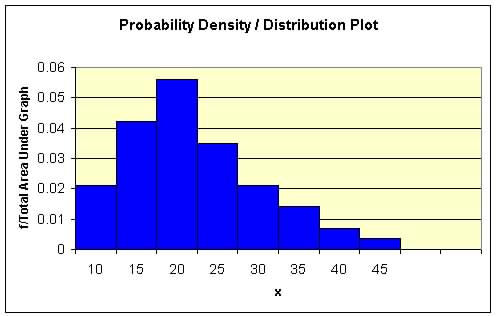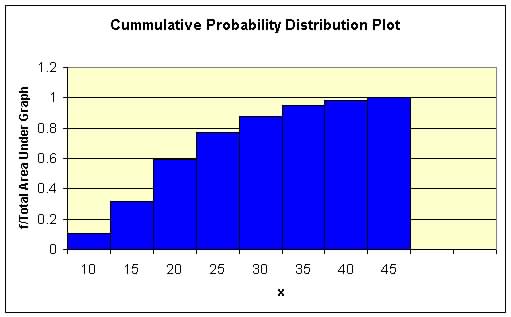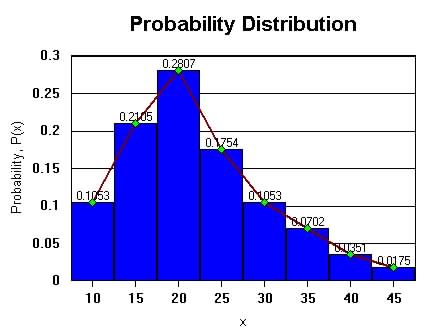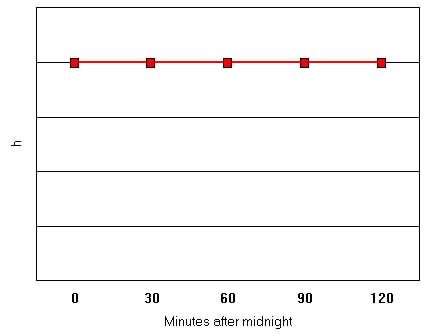A class of continuous random variable is that of the normal random variable. Most researcher make assumptions based on the normal distribution of this variable because it offers many useful generalizations and rules or theorems, such as the Central Limit Theorem.
The probability distribution or density function of a continuous random variable is related to the area under the curve of the function and not the relative frequencies as do discrete random variables.
1. Know how to construct a probability distribution or adjusted histogram from a frequency distribution table of a continuous random variable.
The conversion of a frequency distribution to a probability distribution is also called an adjusted histogram. This is true for continuous random variables.
To convert a frequency distribution to a probability distribution, divide area of the bar or interval of x by the total area of all the Bars.
![]()
A simpler formula is:
![]() ,
N
is the total Frequency and w is the interval of x.
,
N
is the total Frequency and w is the interval of x.
Example
(From a frequency distribution table construct a probability plot).
Table 6a.1.
Frequency Table:
The width of each bar or interval, w = 5(20-15, or 45-20, etc.) See Example below for Area |
Table 6a.2.
Adjusted Histogram - Probability Distribution,
w
= 5
|
||||||||||||||||||||||||||||||||||||||||||||||||
| Figure 6a.1. Probability
Distribution Plot.
|
Figure 6a.2. Cumulative
Probability Distribution Plot
|
2. Know how to interpret the graph of a continuous probability distribution or adjusted histogram.
The graph of a probability distribution in addition to telling us about the nature of the random variable can give us information about the following:
(1) The probability density of the variable
(2) The probability of x at any point
(3) The probability between an interval a and b
(4) The cumulative probabilities
(5) The probabilities, at certain range of values.
| Knowing how to read or determine these information is important for the rest of this course, since the uncertainty or probability of various distributions will be needed to make inference or judgment about sample data or statistics. |
Example:
Consider the probability distribution plot of a continuous
random variable shown in Figure 6a.3 below:
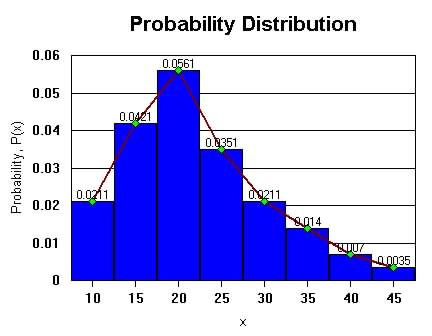 |
Figure 6a.3. Probability
Distribution Plot of Continuous Random variable, x
P(x between 17.5 and 22.5)=0.0561 x 5 = 2805 (Area between the interval)
|
The Nature of the random variable.
The probability distribution plot, gives and indication of the shape of the variable x.
If the random variable is continuous a histogram is just a rough depiction of the variable distribution since the histogram shows only discrete values of the variable. If the frequencies were collected for more data points within the interval of the continuous scale and a curved line is drawn connecting the points as shown in Figure 6a.3 above we call this graph a continuous curve.
P(x) can be viewed as f(x), a function or model that represents the probability of x, P(x) at different values of x.
In more advanced mathematics (beyond the scope of this course), statisticians may by observation and modeling of the shape of the probability curve or distribution or probability density function determine appropriate mathematical formulas for each P(x).
This modeling is called a function, and is often given the equation y =f(x), when y is the dependent variable recorded on the vertical scale which is related to the P(x). The independent variable is x.
Note: In textbooks most continuous variable functions are indicated by curve line graphs, but in actual data collection and summaries, the adjusted histogram is use as an approximation.
(1) The probability density of the variable
From the probability plot the individual probability values at various
values of x can be determined or approximated.
| The probability
that a continuous random variable assumes some value in an interval
is represented by the area under the portion of the continuous curve of
that interval.
Prob[Interval of x] = Area of Probability Destiny Function for that same interval |
|
|
Table 6a.3.
Probability - Area under Graph
The interval width, w = 5 (intervals do not overlap)
|
| The total area under the probability plot add up to 1. |
Problems: (assume for problem above that the intervals do not include the upper bound, i.e. An interval of 7.5 to 12.5 does not include the value 12.5)
1. Find Pr[ x < 22.5]
P(x< 22.50 = P( ![]() )
= Area under the graph from 7.5 to 22.5
)
= Area under the graph from 7.5 to 22.5
From table above P(x < 22.5) = 0.1053 + 0.2105) = 0.3158
2. Find the Pr[ 17.5 < x < 32.5] = Area of [ 17.5 < x < 32.5]
= 0.2807 + 0.1754 +0.1053 = 0.5614
(2) The probability of x at any point
For continuous random variable the probability for an exact value of x is = 0, since the interval width is so small that is almost impossible to tell the exactly value of P[x=a], where a is an exact value or number.
(3) The probability between an interval a and b
1. Find Pr[ x < 22.5]
P(x< 22.50 = P( ![]() )
= Area under the graph from 7.5 to 22.5
)
= Area under the graph from 7.5 to 22.5
From table above P(x < 22.5) = 0.1053 + 0.2105) = 0.3158
2. Find the Pr[ 17.5 < x < 32.5] = Area of [ 17.5 < x < 32.5]
= 0.2807 + 0.1754 +0.1053 = 0.5614
(4) The cumulative probabilities
The Cumulative probability is the probability of the variable up to a certain value a.
Example. Find Pr[ x < 22.5]
P(x< 22.50 = P( ![]() )
= Area under the graph from 7.5 to 22.5
)
= Area under the graph from 7.5 to 22.5
From table above P(x < 22.5) = 0.1053 + 0.2105) = 0.3158
(5) The probabilities, at certain range of values.
| For a continuous
random variable, x
Pr[ |
Problem: Assume that the time of birth of a New Year's baby at
a city hospital will be some random time between midnight and 2:00 am.
Let x be the number of minutes after midnight that the baby will be born.
So ![]() .
(60 minutes in a hour - 2 hours after midnight gives us 120 minutes). The
graph of the probability distribution is shown below (x is a uniform
distribution - same value at each value of x).
.
(60 minutes in a hour - 2 hours after midnight gives us 120 minutes). The
graph of the probability distribution is shown below (x is a uniform
distribution - same value at each value of x).
| Uniform Distribution of x (continuous
random variable).
|
(a) What
is the area of under the graph?
What is the height of h? (b) What is the probability that the New Year's baby will be born (i) Before 12:30 am? (ii) After 1:15 am? (iii) Between 12:45 and 1:00 am? (iv) Before 12:15 am or after 1:30 am? (c) Express parts (i), (ii), and (iii) of part (b) in one of the following forms: P(a<x<b), P(x<a), or P(x>a) |
Worksheet Adjusted Histogram for Probability Distributions of Continuous Random Variables.
To calculate the Probability Distribution for a Continuous Random Variable
Probability - Area under Graph - Example
The interval width, (1) w
= ____ (intervals do not overlap)
| Midpoint
Values
x |
Interval
Values |
P(x) | Area=
wP(x) |
| Sum = 1 |
